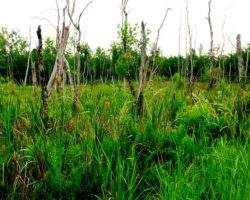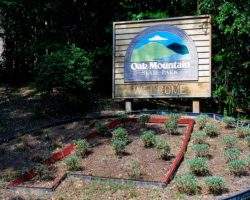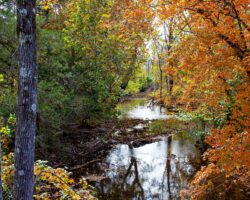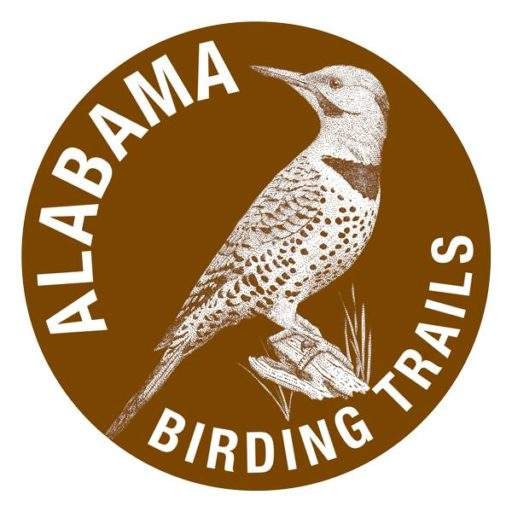Appalachian Highlands | Shelby | Best Seasons: Fall | Spring | Winter
Limestone Park’s interesting combination of wetlands, grasslands, and Tupelo Gum swamp is good for wading birds, swamp and marsh birds, grassland species, and some waterfowl in winter. You will also find songbirds and shorebirds in migration. Best birds are Anhinga (breeds here), and Bobolinks, Dickcissels, and Grasshopper Sparrows (late spring). A Roseate Spoonbill has been spotted here in a few summers. The City of Alabaster and Birmingham Audubon built a handicapped-accessible Birding Observation Deck overlooking the wetlands on the North-western side of the park, with adjacent parking for all. Located in a rural industrial area in southern Shelby County, this park preserves a rich remnant of the habitat mosaic that makes this area especially attractive to birds.
Upon passing through the entrance gate from Highway 31, pause to bird the copse of oak-hickory woods to the south. This is a good area for songbirds, and may be productive for migrants in spring and fall, particularly after a passing weather front. There is a low area to the right that often holds water during wet periods; search the ditch for Wilson’s Snipe and Song Sparrows (fall to spring), small sandpipers and plovers in migration, and Common Yellowthroats (mostly spring to fall). This field and the open fields to the south fill up with clover in late spring, which attracts passing Bobolinks, Dickcissels, and Grasshopper Sparrows, among others. The power lines always have Eastern Bluebirds, Eastern Phoebes, and Mourning Doves on them, but from spring to fall watch for Eastern Kingbirds. Loggerhead Shrikes are seen here irregularly. In fall, American Kestrels appear in small numbers. Northern Harriers are often seen in winter.
There are old fields on both sides of the gravel road. They are frequented by Eastern Meadowlarks and a few Northern Bobwhites. The edge where the mowed grass meets the taller old-field grasses to the south and southwest is good for Field Sparrows, and Palm Warblers can be found in large numbers in fall and spring. Some may winter here. Look and listen for Yellow-breasted Chats and even Prairie Warblers toward the rear of the old-field grasses.
The City of Alabaster’s birding Observation Deck, built in part with a grant from Alabama Audubon, overlooks wetlands to the northwest. Take a moment to examine the interpretive panel at the beginning of the accessible walk to the deck to learn more about the flora and fauna that live in this special place. You can drive in and park here, close to the entrance to the observation deck ramp. Much of this area has been planted with native prairie flowers and grasses, so expect the bird population to boom in coming years. Butterflies are plentiful. This spot attracts Swamp and Song Sparrows. A few Marsh and Sedge Wrens stop here in the cooler months, and this should be a fabulous spot to look for Lincoln’s Sparrows in winter. (There are other similar marshy areas around the park.) The mudflats and pools in this area host numerous herons, as well as Greater and Lesser Yellowlegs, Pectoral Sandpipers, and other migratory shorebirds during spring migration, as well as some ducks in winter and in migration.
The snags in the plentiful dead trees are often occupied by Fish Crows, raptors, and herons. A Purple Martin colony is located in a mobile home park nearby, and these birds often fly over the park or perch on trees and wires here. Barn and Rough-winged Swallows are present from late March to September, and Bank Swallows are visible in migration. Tree Swallows also nest here.
This marsh and swamp at the northeast corner of the park is also the best location to spot the great waders. Great Blue Herons and Great Egrets are present in good numbers year-round. During the nesting season, there is a large rookery in a nearby swamp, and the adult birds can be seen flying back and forth constantly bringing food to their young. Other herons and egrets are most numerous in early spring, late summer and fall. The best birds here are the Anhingas, which have nested here or very nearby for the last several years. As many as 8 Wood Storks have been seen here. Stay vigilant for other interesting birds here, as this is one of the northern most locations for some species.
Before exploring the rest of the site, please note that visiting birders are asked to respect the activities of the RC aircraft club who also use the park. Their varied model aircraft are visible (and audible) on most mornings. However, the birds seem to have accepted their mechanical neighbors, and rarely react. Birders are asked to stay clear of the area set aside for this activity.
There is a large pond in the center of the park. Generally American Coots and a Pied-billed Grebe or two are present much of the year (usually not during the breeding season), along with Killdeer on the banks and nearby grass. Other shorebirds and waders are seen in and around the pond from time to time. Continue along the gravel road past the RC aircraft strip. The skies above are open, and this is a good spot to scan for soaring raptors. Both Turkey and Black Vultures are permanent residents, as are Red-tailed and Red-shouldered Hawks. During fall migration soaring hawks may be seen here in larger numbers, but raptors are always likely to be on view.
A roughly-mowed pathway leads from this road to the far northwestern corner of the park, where there is a good vantage point for scanning the seasonal pools and wetlands from another perspective. As many as 100 American Coots have been seen swimming in the chain of seasonal pools here along with Blue-winged Teal, and Red-winged Blackbirds are present all year. Other wetland birds (Common Yellowthroats, Swamp Sparrows, etc.) are also regulars. This part of the park is the best location for seeing LeConte’s Sparrows in migration and winter.
GPS: 33.1857985 -86.7635383
Limestone Park, City of Alabaster
2400 Hwy. 31 South
Alabaster, AL
(205) 664-6800
Amenities: parking, trails
Hours: 6 A.M.-dusk
Fee: Free
Site Accessibility
The boardwalk ramp and covered observation deck are wheelchair accessible, but access to the ramp can be challenging when the area is muddy. The deck provides excellent views of a small wetland area large enough to attract Pied-billed Grebes and other ducks, plus a variety of waders. The remainder of the trails are generally level, but rough and not suitable for traditional wheelchair access. They can be very muddy depending on the weather. Birding by car can be very productive here.
From I-65 in Shelby County, take exit 238 to US 31 South. Extensive dining and shopping is available at the exit, as well as fuel and lodging nearby. Follow US 31 south for 4.2 miles, turning right onto a gravel road with a yellow pipe gate. The address is 2400 Highway 31 South, Alabaster, AL 35080. There is no admission fee. The gate to the park is open from 6 a.m. to dusk, throughout the year. The gate is just past Saginaw Pipe and the entrance sign of a mobile home area. Keep an eye out for the park's large, blue entrance sign.
Amenities Available: Viewing Platform, Wheelchair Accessible
Nearby Sites

Ebenezer Swamp
Ebenezer Swamp Ecological Preserve is an upland hardwood swamp on Spring Creek, made accessible for nature-lovers by a boardwalk built and maintained by the University of Montevallo. The dominant tree is the Tupelo Gum, with a rich mixture of other h …

Oak Mountain State Park
Alabama’s largest state park, Oak Mountain offers a rich variety of good birding spots. The fishing lakes at the northeast end of the park, especially the woods around the lower fishing lake, can be amazingly productive. Allot a good portion of your …

Shoal Creek Park
Shoal Creek Park consists of 167 acres of largely open lands and wooded margins with Shoal Creek running through the property. Shoal Creek itself tends to have a good flow with riffles and slower moving stretches.
